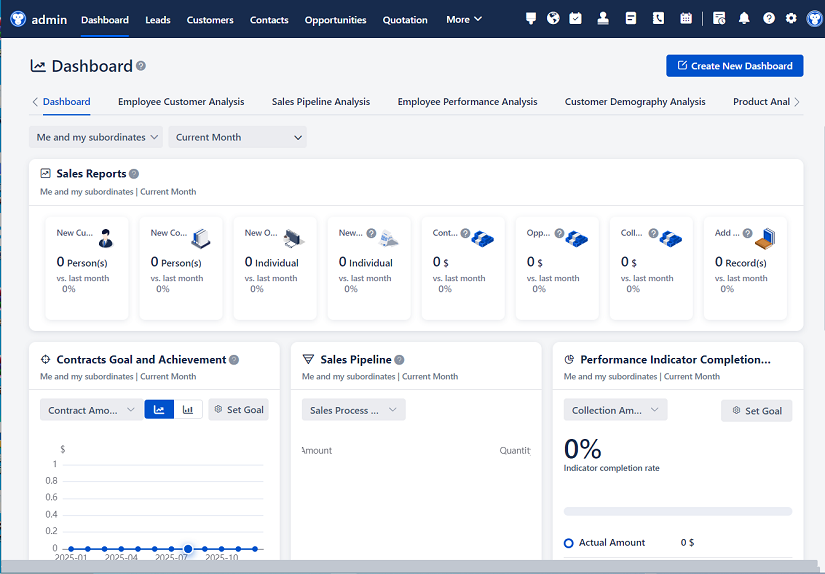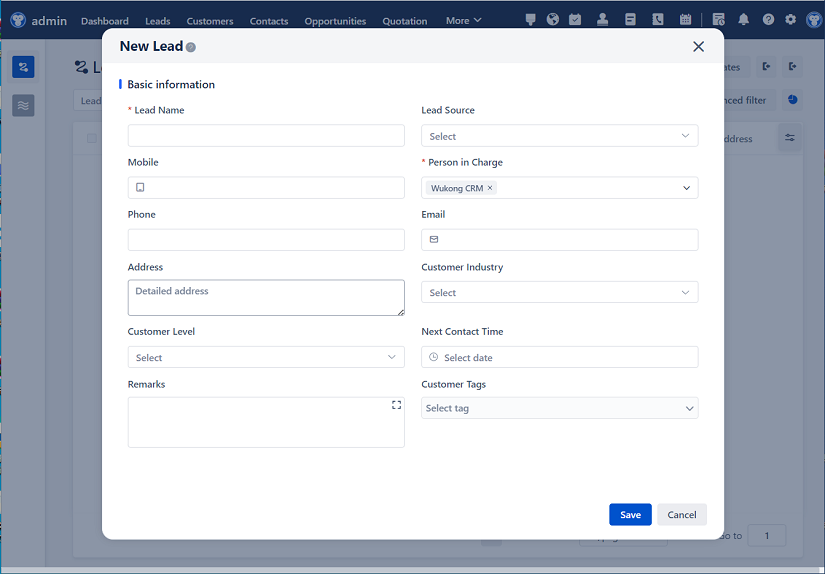
△Click on the top right corner to try Wukong CRM for free
So, you’ve probably heard people talk about WeChat CRM, right? I mean, it’s kind of everywhere these days if you’re doing business in China—or even just trying to understand how Chinese consumers interact with brands. But honestly, when I first heard the term, I was like, “Wait, isn’t WeChat just a messaging app?” I thought it was like WhatsApp or something. But then I started digging deeper, and wow, I had no idea how powerful it actually is.

Let me break it down for you—because I remember feeling totally confused at first. So, WeChat CRM isn’t just about sending messages. It’s actually a whole system that lets businesses manage their customer relationships directly inside the WeChat ecosystem. And when I say “ecosystem,” I really mean it. WeChat isn’t just an app; it’s like a mini internet inside your phone. You can chat, pay bills, order food, book appointments, play games, and even manage your business—all without leaving WeChat.

Now, imagine being able to connect with your customers right where they already spend most of their time. That’s the magic of WeChat CRM. It’s not about pulling people to your website or making them download another app. It’s about meeting them exactly where they are. And trust me, in China, that place is WeChat.
So how does it actually work? Well, businesses usually start by setting up a Official Account—either a Subscription Account or a Service Account. Think of it like a branded profile where customers can follow you, kind of like a Facebook Page. But here’s the thing: it’s way more functional. You can send personalized messages, push updates, offer customer service, and even integrate mini-programs, which are like lightweight apps inside WeChat.
I remember when I first saw a mini-program in action—it blew my mind. You don’t have to download anything. You just tap on it, and it opens instantly. A friend of mine runs a skincare brand, and she uses her mini-program for everything: product browsing, online purchases, loyalty points, and even virtual skin consultations. All of it happens inside WeChat. No redirects, no extra steps. Super smooth.
And here’s where CRM comes in. With WeChat CRM tools, businesses can track user behavior—like which articles they read, what products they look at, how often they interact with messages. That data? It’s gold. It lets companies personalize their communication in a way that feels natural, not creepy. Like, if someone keeps checking out winter coats, you can send them a special offer on down jackets—right inside their chat window. Feels helpful, not pushy.
Another cool thing is customer tagging. You know how in email marketing, you segment your lists? WeChat CRM lets you do that too, but even better. You can tag users based on their behavior, location, purchase history, or even how they found your account. So if someone attended your online event last month, you can tag them as “event attendee” and send them follow-up content or exclusive discounts. It makes marketing feel way more personal.
Oh, and let’s talk about automation. I used to think automation was just for big companies with huge budgets. But WeChat CRM tools have made it super accessible. You can set up auto-replies for common questions, trigger messages based on user actions, or even schedule content to go out at the best time. For example, if someone follows your account, they automatically get a welcome message with a discount code. Simple, but effective.
But here’s what really surprised me—customer service inside WeChat is next level. Instead of making people call a hotline or wait for an email reply, businesses can offer real-time support through WeChat. And not just text—voice messages, video calls, file sharing, the whole deal. I once had an issue with a hotel booking, and the staff resolved it over WeChat in less than 10 minutes. They sent me a new confirmation, a map, and even a personal apology. Felt like they actually cared.
And because everything is tied to a user’s WeChat ID, the experience is continuous. You don’t have to repeat yourself every time you contact a brand. Your history is there. Your preferences are remembered. It’s like having a personal assistant who knows your whole story.
Now, I know what you might be thinking—“But isn’t WeChat only popular in China?” Well, yes and no. It’s true that WeChat dominates in China, but its influence is spreading. A lot of international brands that want to reach Chinese tourists or expats are using WeChat CRM to stay connected. I’ve seen hotels in Paris, shopping malls in London, and even universities in Australia set up WeChat accounts just to serve Chinese students and visitors.
Plus, WeChat Pay is a game-changer. Once a user links their bank card or connects their payment method, they can pay for anything—online or in-store—without pulling out their wallet. For businesses, that means faster checkouts, fewer abandoned carts, and higher conversion rates. It’s not just convenient; it’s addictive.
But let’s be real—WeChat CRM isn’t perfect. There are challenges. For one, the platform is tightly controlled by Tencent, and the rules can be strict. You can’t just blast promotional messages to everyone. There are limits on how often you can message users unless they’ve interacted with you recently. So spammy tactics? They don’t work. You actually have to earn attention.
Also, setting up a strong WeChat CRM strategy takes time and know-how. You can’t just copy-paste your Western marketing playbook and expect it to work. The culture is different. Chinese consumers expect more value upfront—like useful content, entertainment, or instant benefits. They don’t just follow brands because of ads. They follow because the brand adds something to their daily life.
I remember talking to a marketing manager at a luxury fashion brand, and she told me they had to completely rethink their approach. Instead of just posting product photos, they started sharing behind-the-scenes videos, styling tips, and even live-streamed fashion shows. Engagement went through the roof. People weren’t just buying products—they were joining a community.
And that’s the thing: WeChat CRM isn’t just about managing customers. It’s about building relationships. It’s about being helpful, consistent, and human. When done right, it doesn’t feel like marketing. It feels like a conversation.
Another thing I’ve noticed is how integrated everything is. Unlike in the West, where you might use five different tools—email, social media, live chat, CRM software—WeChat brings it all together. One platform, one login, one experience. For businesses, that means less tech hassle. For customers, it means less friction.
And let’s not forget data privacy. I know some people get nervous about that. But WeChat actually gives users a lot of control. They choose who to follow, what to share, and when to engage. And businesses can only message users under specific conditions—usually after the user has initiated contact or given permission. So it’s not like you’re getting bombarded with random ads.
From a business perspective, the ROI can be huge. I’ve seen small businesses in China grow their customer base by 300% in a year just by using WeChat CRM effectively. How? By focusing on value, consistency, and real engagement. They weren’t trying to sell every single message. They were building trust.
And trust is everything in China. Relationships—what they call “guanxi”—are the foundation of business. WeChat CRM works so well because it supports that culture. It’s not transactional; it’s relational. You’re not just selling a product. You’re maintaining a connection.
Now, if you’re thinking about getting into WeChat CRM, here’s my advice: start small. Don’t try to do everything at once. Pick one goal—maybe improving customer service or launching a loyalty program—and build from there. Use analytics to see what’s working. Talk to your customers. Ask them what they want. And most importantly, be patient.
Because let’s face it—WeChat is complex. There’s Official Accounts, Mini Programs, WeChat Pay, Moments ads, Enterprise WeChat, and so much more. It can feel overwhelming. But the good news is, there are tons of third-party tools and agencies that can help you navigate it. You don’t have to build everything from scratch.
And hey, even if you’re not targeting China right now, understanding WeChat CRM can still teach you a lot. It shows what’s possible when technology, culture, and customer experience come together. Imagine if more platforms focused on deep relationships instead of just quick sales. The whole game would change.
So, to wrap this up—WeChat CRM isn’t just a tool. It’s a mindset. It’s about being where your customers are, speaking their language, and adding real value to their lives. It’s not flashy or loud. It’s quiet, consistent, and human. And honestly? That’s what great customer management should be, no matter where you are in the world.

FAQs (Frequently Asked Questions):
Q: Can businesses outside China use WeChat CRM?
A: Absolutely! If you’re targeting Chinese consumers—whether they’re in China or traveling abroad—WeChat CRM is essential. Many international brands in retail, hospitality, and education already use it successfully.
Q: Do I need to speak Chinese to run a WeChat CRM strategy?
A: Not necessarily, but it helps. You’ll definitely need Chinese-speaking staff or partners to create content and manage customer interactions effectively. Localization is key.
Q: Is WeChat CRM expensive to set up?
A: It depends. The Official Account itself is free to register, but costs come from development (like mini-programs), marketing, and third-party CRM tools. Small businesses can start simple and scale up.
Q: Can I integrate WeChat CRM with my existing CRM system?
A: Yes, many third-party platforms offer integration with tools like Salesforce, HubSpot, or Zoho, so you can sync customer data across systems.
Q: How do I measure success with WeChat CRM?
A: Look at engagement rates, message open rates, mini-program usage, customer retention, and conversion rates. WeChat’s built-in analytics give you solid insights.

Q: What’s the difference between Enterprise WeChat and regular WeChat CRM?
A: Enterprise WeChat is like a professional version—it’s designed for internal team collaboration and secure customer communication, often used by larger companies for sales and service teams.
Q: Can I use WeChat CRM for B2B businesses?
A: Definitely. Many B2B companies use WeChat to share industry insights, host webinars, and maintain relationships with clients—all within the ecosystem.
Q: Are there any risks with WeChat CRM?
A: The main risks are violating Tencent’s rules (which can lead to account suspension) or failing to provide value, which leads to unfollows. Always follow best practices and focus on user experience.
Related links:
Free trial of CRM
Understand CRM software
AI CRM Systems

△Click on the top right corner to try Wukong CRM for free